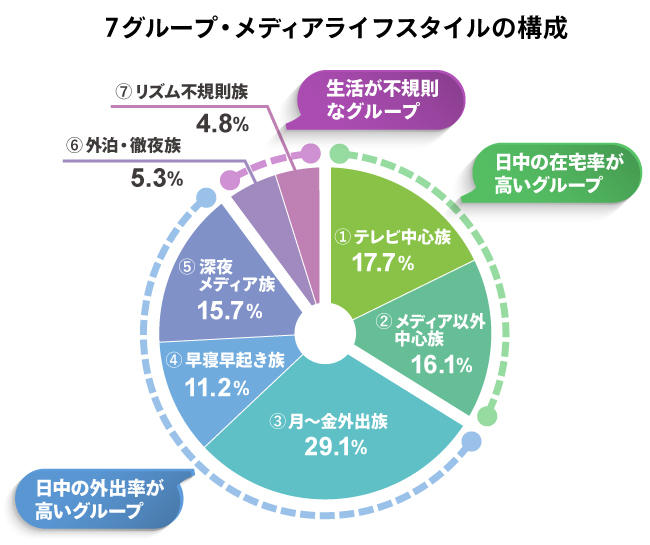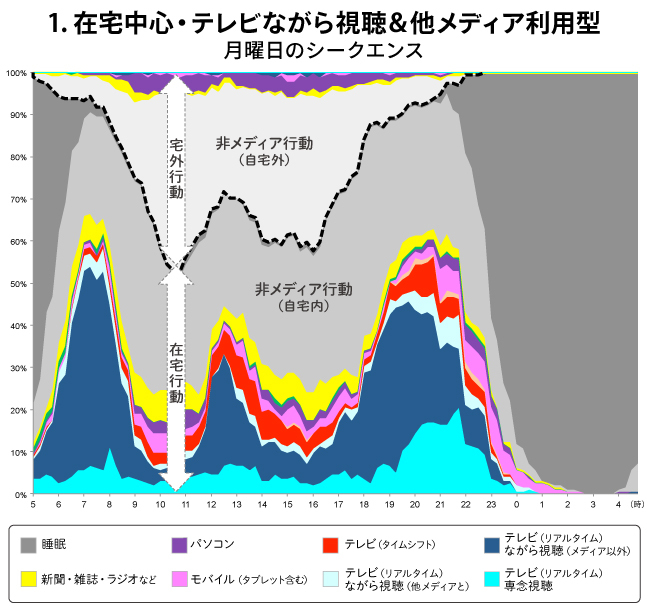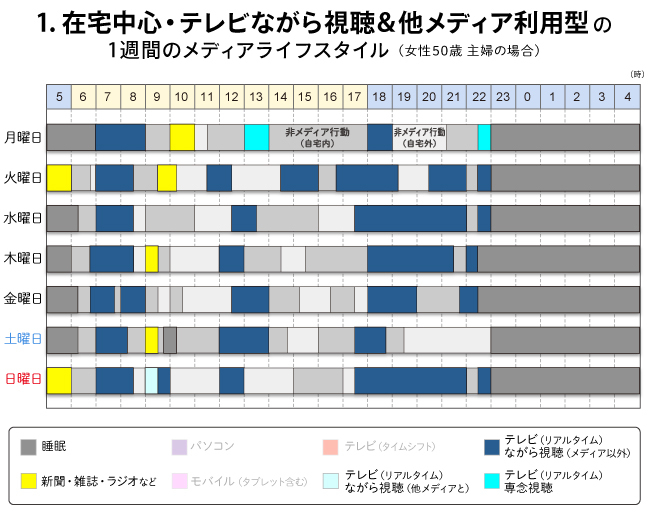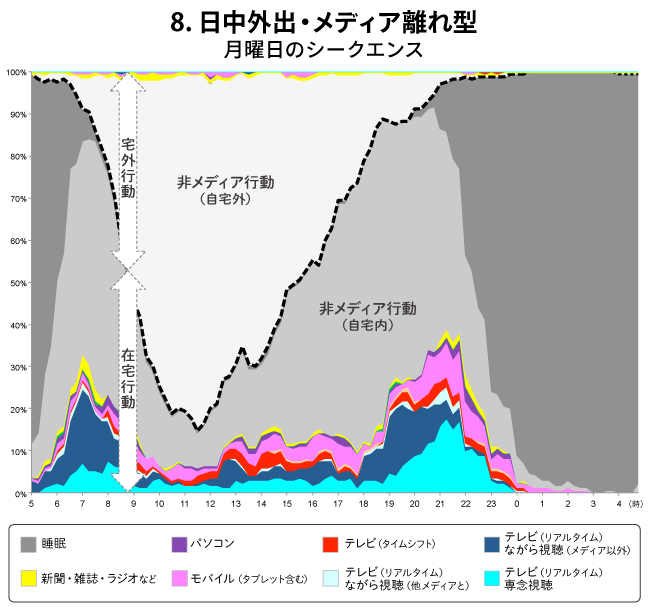Dentsu Media Innovation Lab, in collaboration with Video Research Ltd.'s Human Research Institute, conducted a project to analyze modern media lifestyles across seven groups and 30 distinct styles. The first installment of this series introduced the project's overall framework.
As mentioned previously, the seven groups were broadly categorized into three types based on their basic daily or weekly life cycles:
・Groups spending most of their time at home: "① TV-Centric Group," "② Non-Media-Centric Group"
・Groups with high daytime outings: "③ Weekday Outing Group" and "④ Early-to-Bed, Early-Riser Group"
・Groups with irregular daily or weekly routines: "⑥ Overnight Stayers/All-Nighters" and "⑦ Irregular Rhythm Groups"
Over the next three installments, we will explain the characteristics of the media lifestyles for each of these three groups.
This time, we focus on the two groups that are primarily at home for most of the day: "① TV-Centric Group" and "② Non-Media-Centric Group". We will explain their characteristics, incorporating profiles derived by cross-referencing the media lifestyle analysis results with data on gender, age, occupation, family structure, and more.
Seven Styles of the "TV-Centric Group"
First, let's look at "① TV-Centric Group".
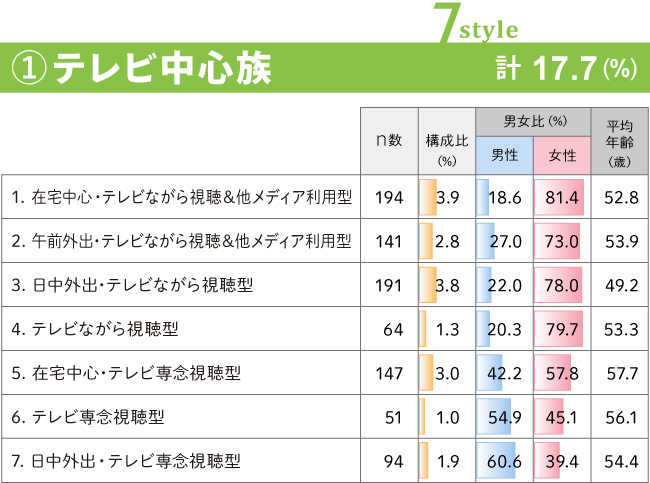
The seven styles within this group share common ground: they spend a significant portion of their time at home, with much of that time devoted to watching TV. What differentiates them is how three key factors combine: "When do they tend to go out?", "Is their TV viewing focused or multitasking?", and "Do they also use other media during their active hours?".
While this group is generally centered around female homemakers in their 50s, the latter three types ("5. Home-Centered, Dedicated Viewing Type," "6. Dedicated Viewing Type," "7. Daytime Outings, Dedicated Viewing Type") are characterized by a significant or even majority presence of men. The keyword "dedicated viewing" already offers a glimpse into the lifestyles of TV-loving men aged 50 and above.
Conversely, the first four types all carry the keyword "multitasking viewing." Women make up 80% of the population driving these four viewing styles.
This time, let's examine the "1. Home-based, TV-while-doing-other-things & other media usage" type, which exemplifies the typical characteristics among the seven styles of "TV-centric tribes."
Characteristics of "1. Home-Centered, TV Background Viewing & Other Media Usage Type"
Women make up 81.4% of this type, with housewives accounting for 64.9%. The average age is in the early 50s. Looking at household composition, two-generation households (parents and children, or couples and parents) make up 60%. As seen in the light gray ridgeline, over 50% of people are at home even during the day.
Key characteristics of this type's media engagement include:
① Against a backdrop of high daily at-home rates, three distinct peaks—colored for morning, afternoon, and evening—are clearly visible.
② Television viewing dominates media consumption (light blue and blue). However, most of this viewing occurs while engaged in other daily activities (blue).
③ Throughout the day, multitasking radio listening while at home is also prominent (yellow).
Let's examine one individual classified under this style, using their weekly activities as an example.
Looking at this respondent's daily cycle, they wake up between 5 and 6 AM, leave home around 10 AM, and return home by noon. While there are one or two more outings in the afternoon and evening, they spend the majority of their time at home.
Regarding media consumption, it's clear that "background TV viewing" (shown in dark blue) dominates their overall media engagement. Dedicated TV viewing (light blue) represents only a very small portion of their TV time. Yellow indicates background engagement with newspapers, magazines, and radio. This heavy reliance on background media consumption is a defining characteristic of this style.
What kind of media lifestyle do you imagine based on this information? You might picture a typical housewife: busy every day sending her husband and children off, managing household chores, yet keeping her antennae tuned to the world by gathering various information from TV and radio.
The Five Styles of the "Non-Media-Centric Group"
How about the "② Non-Media-Centric Group"?
Compared to the first group, the five styles in this group involve relatively less time spent watching TV despite having more hours spent at home. That said, this comparison is strictly relative to the "TV-Centric Group."
Within these five styles, three types—"10. Morning/Evening TV Viewers," "11. Busy at Home," and "12. Home-Centered, Evening Media Users"—are characterized by media consumption behaviors that are dispersed across real-time TV viewing, time-shifted viewing, and online activities on PCs or mobile devices.
Another defining characteristic of this group is that women make up about 80% of all five styles, with a high proportion in their 40s, and the majority are homemakers.
Characteristics of "8. Daytime Outing/Media-Avoiding Type"
Let's examine the characteristics of "8. Daytime Outing/Media-Avoiding Type," a subgroup within this category that exhibits lower overall media engagement.
Even in this type, women make up nearly 90% of the group. The average age is in the early 40s, about 10 years younger than the "TV-Centric Group." In terms of family structure, two-generation households account for 80%.
However, compared to the other four types, the proportion of homemakers is the lowest at 48.8%, while those employed in sales and service occupations account for 19.4%. Regarding their work patterns, 27.1% work part-time or as temporary workers for three or more days a week, which is higher than any other type within this group.
Against this backdrop, while most people are out during the midday hours, around 3 PM, half have already returned home. Despite the high rate of people being at home, the colored sections indicating media contact are generally low.
Let's outline the characteristics of media engagement.
① There is almost no peak in media contact during the day, and the morning and evening peaks are not particularly high either.
② Among media activities, TV viewing remains the most common throughout the day, but mobile internet use (pink) is the second most frequent activity.
Let's examine one individual classified under this style, using their weekly activities as an example.
This shows the weekly media lifestyle of a 34-year-old woman in sales/service roles belonging to this type. On weekday days, she leaves home around 8:30 AM, but returns by 2 PM on Mondays and Tuesdays, and by 4 PM on Thursdays and Fridays. Since commuting time is included in her outings, this suggests she likely works reduced hours or part-time rather than full-time.
In that sense, this respondent spends relatively long periods at home overall. Within that time, it's clear that her media consumption periods are very limited.
Even so, they maintain a consistent core rhythm of "background TV viewing" around 6:30 AM and 7 PM. Mobile internet usage is also recorded sporadically throughout.
Looking at this lifestyle record, many might picture a woman juggling work, housework, and childcare, leading a hectic day. Among the five "non-media-centric" styles, the absence of a daytime media contact peak seems determined by the underlying rhythm of a lifestyle requiring daytime outings for part-time or temporary work.
Media Consumption Styles Embedded in Daily Life
Both groups introduced here are predominantly female. While both spend significant time at home among the seven groups, their media consumption styles differ greatly based on their life cycles—whether they are full-time homemakers or have days when they work.
Both styles introduced here suggest that media contact behaviors are determined within the context of busy lives. For one group, being occupied with housework and personal tasks leads to a pattern of "background" TV or radio consumption. For the other group, juggling housework, childcare, and work results in limited overall media contact.
Furthermore, by graphing the media lifestyles classified through social sequence analysis and cross-referencing them with data on gender, age, occupation, and family structure, we gained a richer understanding of how media consumption behaviors are embedded within daily life cycles—such as time spent at home, outings, and sleep.
Next time, building on these characteristics of social sequence analysis, we will introduce the features of three groups: "③ Weekday Outing Group" (high daytime outings), "④ Early-to-Bed, Early-Riser Group," and "⑤ Late-Night Media Group."

